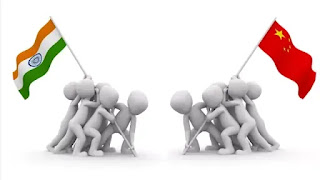Why in News ?
The recent tensions simultaneously at Naku La in Sikkim and Pangong Tso and Galwan in Ladakh (Western sector) of the border since 5 May 2020.
The "premeditated and planned" killing of Indian soldiers at Galwan region on 15 June 2020.
It is showing the dangers of unresolved territorial dispute between the two large Asian countries.
Border Dispute between India and China :
• The McMohan Line, drawn at the Shimla Conference in 1914 and initialled by Nationalist China's representative Chen Yifan, was mentioned as the Line of Actual Control (LAC) in the eastern sector by China's premier Zhou Enlai in his 7 November, 1959 letter to India's Prime Minister Jawaharlal Nehru and line up to which each side exercise actual control in the western sector.
• As new nation states in the late 1940s, and as successive states for previous empires, viz., the British Indian and Qing Dynasty, India and China inherited the undefined boundaries.
• Since independence by the successive leaderships, the territorial limits have neither been defined, delineated nor demarcated, posing concerns or even conflict between India and China.
• There is no mutual agreed Line of Actual Control (LAC).
• India considers the LAC to be 3,488 km long, while the Chinese consider it to be only around 2,000 km. The LAC separates Indian-controlled territory from Chinese-controlled territory.
• The LAC divided into three sectors -
1. Western Sector : 1,680 km long border. It include 8 areas - Pangong Tso, Trig Heights, Samar Lungpa, Demchok, Chushul, Depsang Bulge and Chumar.
2. Middle Sector : 545 km long border. Three area in dispute, viz., Barahoti, Kauril and Shipki.
3. Eastern Sector : 1,126 km in length. Six area in dispute, viz., Longju, Asaphila, Namka Chu, Samdurong Chu, Chantze and Migyutun.
• India emphasis on the McMohan Line in eastern sector, while the Chinese side had asked for concession in Tawang sector based on religious reasons of being the 16th century Dalai Lama's birthplace.
• India's support for the Dharamasala regime is huge issue for China.
India's land Boundaries with :
1. Pakistan
2. Afghanistan
3. Nepal
4. Bhutan
5. Bangladesh
6. Myanmar
7. China
and Maritime boundaries with
8. Sri Lanka
India is continuously facing security thread from above these nations. Major territorial trouble from Pakistan (at LoC, Rann of Kachh) and China.
China's Expansionist Mindset :
• The incidents on Line of Actual Control (LAC) by China - Depsang Plains in April-May 2013, Chunar in 2014 & 2015, Dokhlam crisis of 2017 and recent incidents in the western sector and Sikkim.
• China's popular websites toutiao.com claimed the whole of Kyrgyzstan as a part of China historically, while sohu.com stated that Kazakhstan is located on China's territories.
• China had claim and objected to Bhutan applying for an environmental project at Sakteng Wildlife Sanctuary at Trashigang district in eastern Bhutan.
• China's expansion over South China Sea.
Mechanisms of Preventing Conflict and Border Stability :
• Peace and Tranquility Agreement, 1993
• Confidence Building Measures (CBM), 1996 in the Military field
• Protocols on not Carrying Arms, 2005
• Border Defence Cooperation Agreement, 2013 on not "tailing" the patrols on the borders.
• 2012 Processes of Consultation and Cooperation.
All of these are aimed at preventing conflict and managing the border stability issues.
On 20th June 2020, for the first time after 1962 border clashes, 1967 Sikkim incident and 1975 Tulungla incident in Arunachal Pradesh which witnessed casualties. In 2020, again large scale mobilisation of armed forces closer to the LAC (estimated to be over 2 division each) also went beyond the past protocols requirements.
India-China territories have witnessed an animated increase in the number of incidents recently such as border transgressions since the 1990s, Depsang Plains incidents in 2013, Chumar incident in 2014 and 2015, Doklam incident in 2017 and currently the violent incidents at Galwan-Pangong Tso regions. Despite several decades of discussion on the border dispute and instituting of CBMs on the borders, recent events on military mobilisation and violent incidents suggest that these signals will have a large bearing not only in bilateral relations but also regional security. This then calls for resolving the territorial security issues between the two Asian giants for peace and stability in the continent.
References
Yojana
PIB


Post a Comment
Post a Comment
Thanks...keep in touch 🤟